2018
Global State of Remote Work
How employees around the world think about working remotely, hybrid and fully remote companies, how learning styles affect remote teams, and more.
Introduction
Remote work is the way of the future. Some companies have adapted to the mentality that with the right setup, employees can work from anywhere. Others have been slower to warm up to the concept, requiring their staff to commute to an office daily. At Owl Labs, we are a fully hybrid team. Employees have the option to work remote, come in to our office in Boston, or switch between the two. In fact, there may be a benefit in doing so. The 2017 State of Remote Work report reinforced the benefit of being a hybrid company. Specifically, companies that offer remote-friendly options see 25% less turnover than those that do not.
It makes sense-- employees are happiest when they have a choice. Are they more productive working from home in the mornings, then showing up to collaborate in the afternoons? Do they get the most done from their bed between 10 pm - 2 am? Giving them to option to choose allows our employees to be autonomous in their schedule and structure their day around when they are the most productive.
Beyond the exploration of hybrid work environments and remote preferences, we also wanted to know how remote work varies around the world. We wanted to find any disparities in remote work opportunities, access, and job satisfaction throughout the continents across the globe.
The annual State of Remote Work report analyzes how employees around the world think about remote work, hybrid teams, motivations for working remotely, and how learning styles affect remote teams.
To gather the data for this report on remote work, we polled 3,028 employees worldwide across 6 continents. (We couldn’t get any data from Antarctica, but we’ll try again in our 2019 report.)
Respondents represented 23 countries and 6 continents.
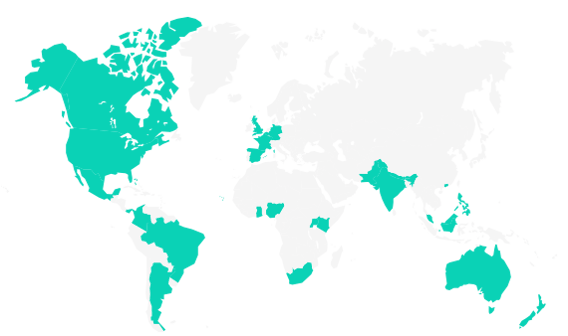
Our respondents were made up of employees at many levels of the corporate ladder.
Respondents by Role
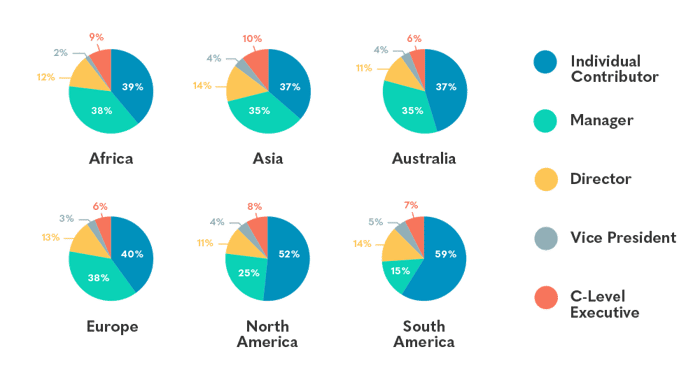
Respondents were from a variety of industries, with many individuals working in healthcare and medical, government, and education.
Respondents’ Industry by Continent
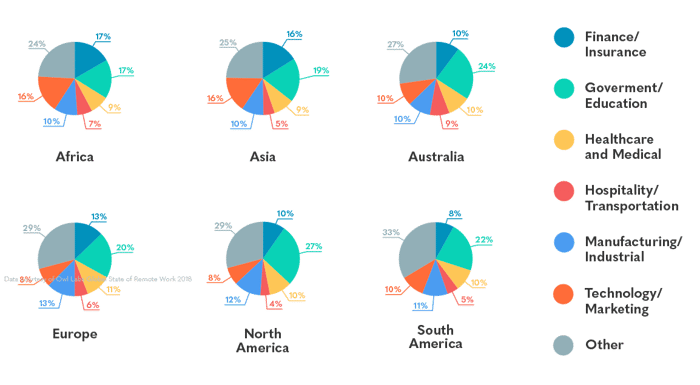
We were also interested to explore how employee learning style may affect remote-work preferences, role, and job satisfaction. Here’s the makeup of our respondents by learning style.
Respondents’ Role by Learning Style
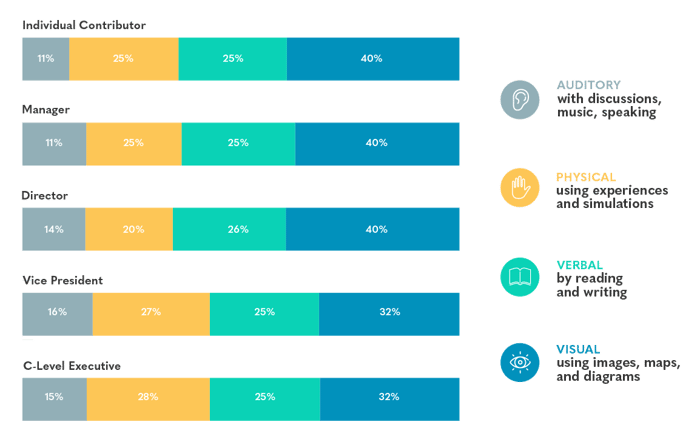
Key Findings
Our data show that 56% of companies allow remote work, “hybrid companies,” or are a fully remote company. Last year, our U.S data revealed that 85% of companies were hybrid- allowing or requiring remote work. However, globally, the majority of companies still don’t allow remote work. 44% of respondents work for companies that don't allow remote work, but interestingly, 16% work for companies that are fully remote. In 2017 in the United States, only 15% of companies did not allow remote work.
44%
of companies don’t allow remote work
These companies require employees to work from an office with no option to work remotely.
16%
of companies are fully remote
These companies are completely remote with no headquarters or office option available. All employees work from workspaces, their homes, or wherever they choose.
40%
of companies are hybrid - offering both remote and in-office options
These companies offer both options; employees can choose to work from an office or shared workspace, work remotely, or alternate between the two. This results in teams and departments that always have a mix of in-person and virtual employees.Global Facts + Figures About Hybrid, Fully Remote, and Companies That Don't Allow Remote Work
When compared to the global average, South America has 81% more fully remote companies.
Asia and South America each have 9% more companies that do not allow remote work than the global average.
Africa and Australia have the most hybrid or fully remote companies with 59% and 60% respectively.
As data trends change in certain industries, regions, and countries, it’s important to have benchmarks against which to compare current statistics. For this report, we have the data from our inaugural report to serve as a baseline for comparison with the data we gathered this year. In our 2017 State of Remote Work, we learned that 52% of employees work remote at least once a week. This was U.S. specific. This year, with respondents from around the globe, the number remains the same at 52% of employees working from home at least once a week. Additionally, 68% of respondents work remote at least once a month, down 2% from last year’s report.
How often do people work remote?

Key Data Points
South American respondents are 67% more likely than average to always work remote.
Men across the globe are 8% more likely than women to work remotely.
How Often Respondents Work Remote by Role
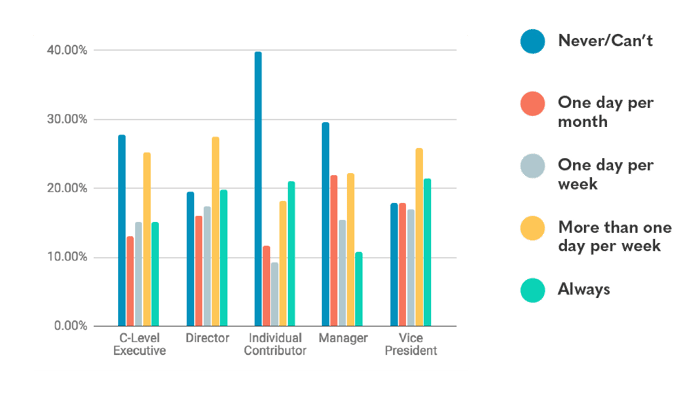
Last year, we discovered that in the United States, full time remote workers are 2x more likely to be individual contributors than management. This year, individual contributors were 20% more likely than average to work remote full time. Additionally, we learned that vice president-level respondents are the most likely, when compared with all other roles, to be fully remote. Individual contributors are the most likely to never work remotely, or not be allowed.
Fun Fact
Those who identified most with the physical learning style (using experiences, simulations, and physical objects) are surprisingly 56% likelier than the average to be fully remote.
Why do people choose to work remote?
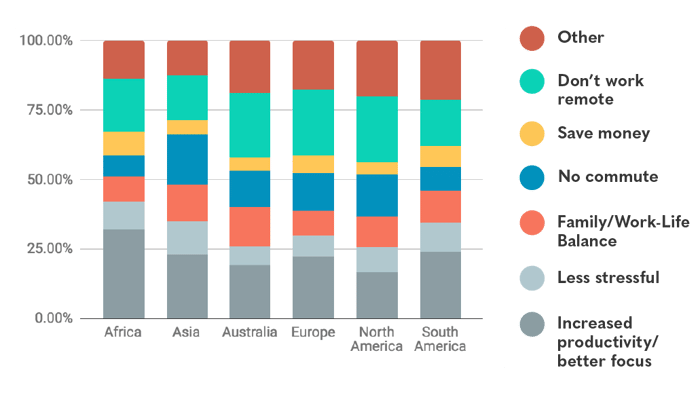
The #1 reason that people choose to work remote is increased productivity/better focus, which was the #3 reason last year. In last year’s report, the #1 reason for respondents in the U.S to work remote was work/life balance and the #2 reason was no commute, which remained the #2 reason this year. This year, only 14% of respondents identified work/life balance as their main reason for working remote, which is less than last year. Productivity and focus remained a top reason to work remote and saving money remained a less important reason amongst respondents.
Respondents in North America are the most likely to work remotely to avoid a commute.
Individuals in Africa are the most likely to work remotely for increased productivity/better focus.
Those in North America are the least likely to work remotely to save money, while those in Africa are the most likely to have this as their #1 reason.
Men are more likely than women to work remotely to focus and be productive.
Men are also more likely to work remote to save money.
Do remote jobs provide more opportunities for quality employment?
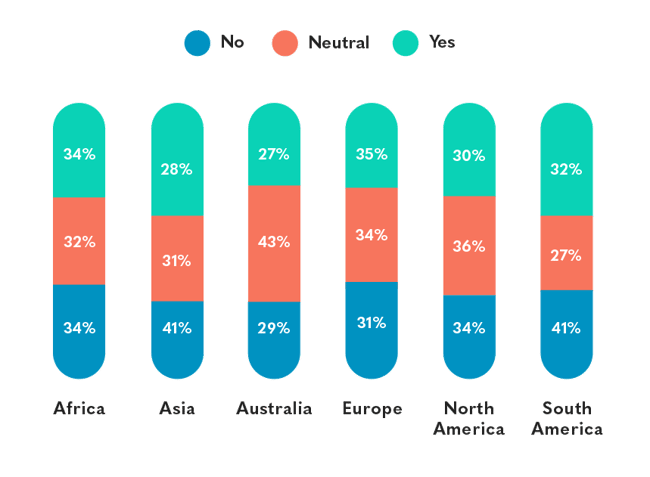
We asked respondents if they feel that there are few or many remote opportunities for both remote and in-person jobs where they live and in their industry. We found that remote work creates opportunities in regions where careers in many roles and industries previously did not exist.
On average, 35% of respondents agree that remote work provides more opportunities for quality employment.
Additionally:
- Those in South America and Asia were 17% more likely than the global average to agree that remote work offers more options for quality employment.
- Respondents in Europe were 13% less likely than average to feel that there are more opportunities when working remote.
- In Africa, 34% of respondents agree and conversely, 34% of respondents disagree.
Respondents in Asia feel that there are few remote job opportunities.
Australian and European respondents report that they feel that there are more in-person job opportunities than remote.
Those in Africa and South America feels like there are few job opportunities altogether.
Those in hospitality and transportation feel that there are few remote job opportunities and many in-person opportunities.
Respondents in technology and marketing feel that there are few remote opportunities and more in-person opportunities.
This was very surprising to us. With modern technology like the Meeting Owl, those in non-location specific industries like marketing, folks should be able to work remote. Tweet at us @owllabs if you have any thoughts why this industry hasn’t adjusted to remote work globally yet.
#StateOfRemoteWork2018
Do you feel happy and productive in your job?
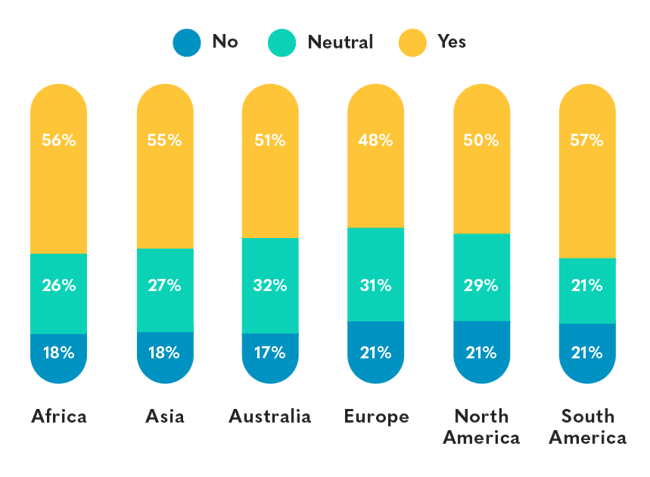
We explored if employees feel happy and productive in their job and analyzed by continent, role, and industry.
Those who work remote at least once a month are 24% more likely to feel happy and productive in their roles than those who don't or can't work remotely.
Happiness and Productivity Key Findings
South American respondents are the most likely to feel happy and productive in their jobs.
Those in Europe are the least likely to feel happy and productive in their jobs.
Men are only 2% more likely to feel happy and productive at work.
C-Level Executives are the most likely to feel happy and productive.
Vice President-level respondents are the least likely to feel happy and productive.
18-24 years olds are the most likely to feel happy with those aged 65+ at a close second.
Respondents aged 25-34 are the least likely to agree that they feel happy in their job.
Overall, more employees feel happy in their job than those that do not feel happy. Specifically, 53% of respondents feel happy!
Learning Styles
We wanted to know if learning style affected employee preferences on working remote, motivations for working remote, and if those at different rungs on the corporate ladder were more likely to be certain types of learners. In our survey, we found that learning styles were distributed fairly evenly across roles. To review, the four types of learning styles are:
Visual (spatial)
Learn best by using images, maps, and diagrams
Aural (auditory/musical)
Learn best in group discussions, listening, speaking, and through music
Verbal (linguistic)
Learn best reading and writing using reports and essays
Physical (kinesthetic)
Learn best using experiences, simulations, and physical objects
Here’s what we gathered from learning style as it relates to remote work (and some interesting tidbits to look through!)
Men are 35% likelier than women to be physical learners.
Women are 26% likelier than men to be verbal learners.
Individual Contributors, Managers, and Directors are the most likely to be visual learners.
Vice Presidents and C-Level Executives are the least likely to be visual learners.
Visual learners are 35% likelier than average to work remotely to gain better productivity/focus.
Auditory and physical learners are 22% more likely than average to work remotely to minimize stress.
Methodology/Demographics
For this survey, we polled 3,028 respondents from 6 continents using Google Surveys. 23 countries in 6 continents were represented, including those whose flags are listed below. The survey was translated into five languages. The data was collected between 9/19/18-9/22/18. Respondents were between the ages of 18-65+
Countries & Languages Represented
Respondents by Age
![]() United States
United States
![]() Canada
Canada
![]() Mexico
Mexico
![]() Brazil
Brazil
![]() Argentina
Argentina
![]() Colombia
Colombia
![]() United Kingdom
United Kingdom
![]() Spain
Spain
English
German
![]() France
France
![]() Germany
Germany
![]() Belgium
Belgium
![]() Hong Kong
Hong Kong
![]() Philippines
Philippines
![]() Pakistan
Pakistan
![]() Malaysia
Malaysia
![]() India
India
French
Spanish
![]() Australia
Australia
![]() New Zealand
New Zealand
![]() Nigeria
Nigeria
![]() South Africa
South Africa
![]() Uganda
Uganda
![]() Kenya
Kenya
![]() Ghana
Ghana
Portuguese
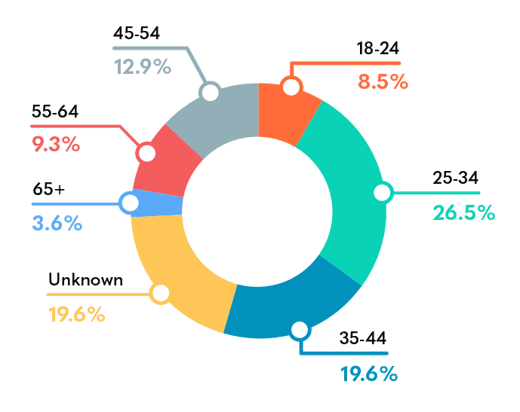
Conclusion
At Owl Labs, we believe that employees should have the ability to work from anywhere with the right technology and support. Remote work provides opportunities in regions where certain roles and industries may not otherwise be available. The State of Remote Work report is a yearly benchmark report where we examine how companies are adjusting to the new normal of hybrid remote and in-office companies and employee autonomy. The data shows that while we have made great progress in certain regions, others have a ways to go to enable their employees to have remote flexibility.
We were surprised by many findings and would love to know more about how you feel about the data. Join the conversation on social media #StateOfRemote2018.
About Owl Labs
We are the creators of the Meeting Owl, an intelligent 360° all-in-one video conferencing camera that centers virtual conferencing around remote participants. Our mission is to create the inclusive meeting experience remote employees deserve.
.png?width=400&name=Meeting_Transformation_Project_logo_final%20(1).png) Ready to make meetings easier for your remote teammates?
Ready to make meetings easier for your remote teammates?
